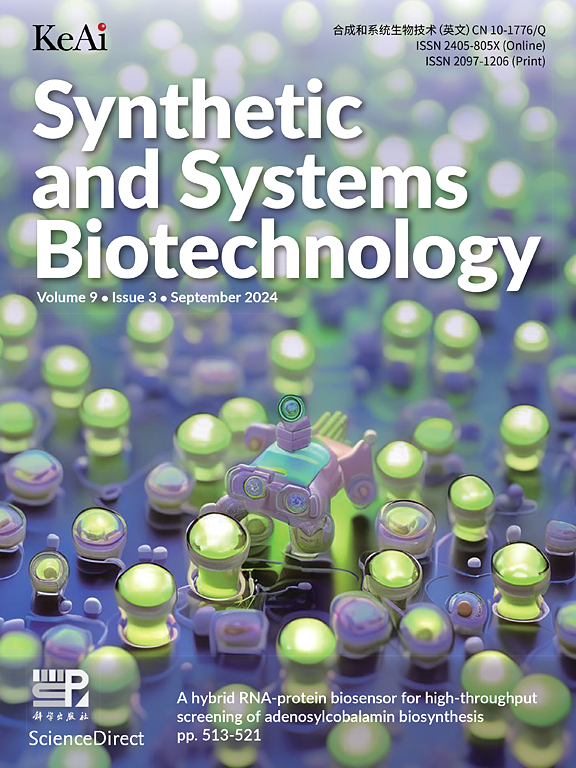基于 CRISPR/Cas12a 的蓝藻噬菌体基因组编辑技术
IF 4.4
2区 生物学
Q1 BIOTECHNOLOGY & APPLIED MICROBIOLOGY
引用次数: 0
摘要
人们已经在蓝藻基因组编辑方面做出了努力,但在噬菌体中实现基因组编辑仍然具有挑战性。编辑蓝藻噬菌体基因组对于理解和操纵它们与蓝藻宿主的相互作用至关重要,从而为控制蓝藻藻华提供潜在的解决方案。在本研究中,我们开发了一种基于 CRISPR-Cas12a 的简化方法,用于高效编辑蓝藻噬菌体基因组,并将该方法应用于 Anabeana sp. PCC.7120 的蓝藻噬菌体 A-1(L) 和 A-4(L)。这两种蓝藻噬菌体基因组中的多个假定基因被编辑和敲除,产生了具有不同抑制蓝藻生长能力的可行突变体。所有这些突变体都对宿主有明显的抑制作用,表明这些基因对噬菌体的生命周期并不重要,而且基因缺失对蓝藻噬菌体感染宿主的效率几乎没有影响。通过在蓝藻噬菌体 A-4(L)中反复同时进行基因敲除,我们获得了基因组最小的突变体,其基因组大小减少了 2400 bp,与野生型(WT)相比减少了 5.75%。总之,这些蓝藻噬菌体突变体有助于鉴定蓝藻噬菌体生物学中的非必要基因,以及为合成生物学研究插入外来基因。这一进展有望解决普遍存在的水华问题及相关的环境危害。本文章由计算机程序翻译,如有差异,请以英文原文为准。
CRISPR/Cas12a-based genome editing for cyanophage of Anabeana sp.
Efforts have been conducted on cyanobacterial genome editing, yet achieving genome editing in cyanophages remains challenging. Editing cyanophage genomes is crucial for understanding and manipulating their interactions with cyanobacterial hosts, offering potential solutions for controlling cyanobacterial blooms. In this study, we developed a streamlined CRISPR-Cas12a-based method for efficient cyanophage genome editing and then applied this method to the cyanophages A-1(L) and A-4(L) of Anabeana sp. PCC.7120. Multiple hypothetical genes were edited and knocked out from these two cyanophage genomes, generating viable mutants with varying capabilities to inhibit cyanobacterial growth. All these mutants displayed significant inhibitory effects on the host, indicating that these genes were non-essential for phage life cycle and the deletion led to little impairment of the cyanophages in infectious efficiency to their host. By iterative and simultaneous gene knockouts in cyanophage A-4(L), we achieved the minimal genome mutant with a 2400 bp reduction in genome size, representing a 5.75 % decrease compared to the wild type (WT). In conclusion, these cyanophage mutants can facilitate the identification of nonessential genes for cyanophages biology and the insertion of foreign genes for synthetic biology research. This advancement holds promise in addressing the widespread issue of water blooms and the associated environmental hazards.
求助全文
通过发布文献求助,成功后即可免费获取论文全文。
去求助
来源期刊

Synthetic and Systems Biotechnology
BIOTECHNOLOGY & APPLIED MICROBIOLOGY-
CiteScore
6.90
自引率
12.50%
发文量
90
审稿时长
67 days
期刊介绍:
Synthetic and Systems Biotechnology aims to promote the communication of original research in synthetic and systems biology, with strong emphasis on applications towards biotechnology. This journal is a quarterly peer-reviewed journal led by Editor-in-Chief Lixin Zhang. The journal publishes high-quality research; focusing on integrative approaches to enable the understanding and design of biological systems, and research to develop the application of systems and synthetic biology to natural systems. This journal will publish Articles, Short notes, Methods, Mini Reviews, Commentary and Conference reviews.
 求助内容:
求助内容: 应助结果提醒方式:
应助结果提醒方式:


